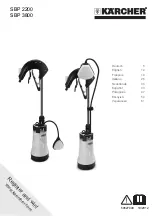
Page 5 of 18
506318-03
Issue 1946
Flushing Line Sets
If the unit will be installed in an existing system that uses
an indoor unit or line sets charged with R-22 refrigerant,
installer must perform the following flushing procedure.
NOTE:
Existing system components (including line set
and indoor coil) must be an AHRI match with the unit in
order to fulfill unit warranty requirements.
Refrigerant must be reclaimed in accordance with
national and local codes.
WARNING
Do
NOT
attempt to flush and re-use existing line sets
or indoor coil when the system contains contaminants
(i.e., compressor burn out).
CAUTION
“Clean refrigerant” is any refrigerant in a system that
has not had compressor burnout. If the system has
experienced burnout, it is recommended that the
existing line set and indoor coil be replaced.
NOTE
In lieu of R-410A, an industry-standard flushing agent
may also be used.
NOTE
LOW
HIGH
EXISTING
INDOOR
UNIT
GAUGE
MANIFOLD
CYLINDER CONTAINING
CLEAN R-410A TO BE
USED FOR FLUSHING
(Positioned to deliver liquid
refrigerant)
LIQUID LINE SERVICE
VALVE
INLET
DISCHARGE
TANK
RETURN
CLOSED
OPENED
RECOVERY
CYLINDER
RECOVERY MACHINE
NEW
OUTDOOR
UNIT
VAPOR LINE
SERVICE VALVE
VAPO
R
LIQUID
1
A
B
C
D
A
Cylinder with clean R-410A (positioned to deliver liquid refrigerant) to the
vapor service valve.
B
Refrigerant gauge set (low side) to the liquid line valve.
C
Refrigerant gauge set center port to inlet on the recovery machine with
an empty recovery tank connected to the gauge set.
D
Connect recovery tank to recovery machine per machine instructions.
Figure 3.
1. Connect gauges and equipment as shown in Figure 3.
2. Set the recovery machine for liquid recovery and start
the recovery machine. Open the gauge set valves to
allow the recovery machine to pull a vacuum on the
existing system line set and indoor unit coil.
3. Position the cylinder of clean R-410A for delivery of
liquid refrigerant and open its valve to allow liquid
refrigerant to flow into the system through the vapor
line valve. Allow the refrigerant to pass from the
cylinder and through the line set and the indoor unit
coil before it enters the recovery machine.
4. After all of the liquid refrigerant has been recovered,
switch the recovery machine to vapor recovery so
that all of the R-410A vapor is recovered. Allow the
recovery machine to pull the system down to 0.
5. Close the valve on the inverted R-410A drum and the
gauge set valves. Pump the remaining refrigerant out
of the recovery machine and turn the machine off.




































